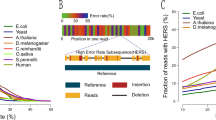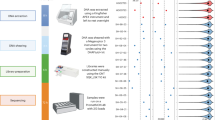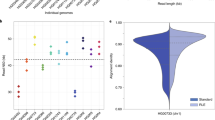Abstract
Long-read sequencing has the potential to transform variant detection by reaching currently difficult-to-map regions and routinely linking together adjacent variations to enable read-based phasing. Third-generation nanopore sequence data have demonstrated a long read length, but current interpretation methods for their novel pore-based signal have unique error profiles, making accurate analysis challenging. Here, we introduce a haplotype-aware variant calling pipeline, PEPPER-Margin-DeepVariant, that produces state-of-the-art variant calling results with nanopore data. We show that our nanopore-based method outperforms the short-read-based single-nucleotide-variant identification method at the whole-genome scale and produces high-quality single-nucleotide variants in segmental duplications and low-mappability regions where short-read-based genotyping fails. We show that our pipeline can provide highly contiguous phase blocks across the genome with nanopore reads, contiguously spanning between 85% and 92% of annotated genes across six samples. We also extend PEPPER-Margin-DeepVariant to PacBio HiFi data, providing an efficient solution with superior performance over the current WhatsHap-DeepVariant standard. Finally, we demonstrate de novo assembly polishing methods that use nanopore and PacBio HiFi reads to produce diploid assemblies with high accuracy (Q35+ nanopore-polished and Q40+ PacBio HiFi-polished).
This is a preview of subscription content, access via your institution
Access options
Access Nature and 54 other Nature Portfolio journals
Get Nature+, our best-value online-access subscription
$29.99 / 30 days
cancel any time
Subscribe to this journal
Receive 12 print issues and online access
$259.00 per year
only $21.58 per issue
Buy this article
- Purchase on Springer Link
- Instant access to full article PDF
Prices may be subject to local taxes which are calculated during checkout





Similar content being viewed by others
Data availability
We have made the analysis data available publicly (variant calling outputs, genome assemblies) in: https://console.cloud.google.com/storage/browser/pepper-deepvariant-public/analysis_data. The source data for the main figures can be found in: https://console.cloud.google.com/storage/browser/pepper-deepvariant-public/figure_source_data/Figure_source_data/.
For sequencing data, we used several publicly available datasets:
• GIAB consortium26,28: https://ftp-trace.ncbi.nlm.nih.gov/giab/ftp/data/
• Human Pangenome Reference Consortium (HPRC): https://s3-us-west-2.amazonaws.com/human-pangenomics/index.html
• Telomere-to-telomere consortium11,12: https://github.com/nanopore-wgs-consortium/CHM13
Please see the Supplementary Notes to find specific links to the sequencing data that we used for our analysis. Source data are provided with this paper.
Code availability
The modules of PEPPER-Margin-DeepVariant are publicly available in these repositories:
• PEPPER: https://github.com/kishwarshafin/pepper
• Margin: https://github.com/UCSC-nanopore-cgl/margin
• DeepVariant: https://github.com/google/deepvariant
The PEPPER-Margin-DeepVariant software57 is available at https://doi.org/10.5281/zenodo.5275510, and we used r0.4 version for the evaluation presented in this manuscript. For simpler use, we have also created a publicly available docker container, kishwars/pepper_deepvariant:r0.4, that can run our variant-calling and polishing pipelines.
References
Altshuler, D. M. et al. An integrated map of genetic variation from 1,092 human genomes. Nature 491, 56–65 (2012).
McKenna, A. et al. The Genome Analysis Toolkit: a MapReduce framework for analyzing next-generation DNA sequencing data. Genome Res. 20, 1297–1303 (2010).
Li, W. & Freudenberg, J. Mappability and read length. Front. Genet. 5, 381 (2014).
Chaisson, M. J. P. et al. Multi-platform discovery of haplotype-resolved structural variation in human genomes. Nat. Commun. 10, 1784 (2019).
Belton, J. M. et al. Hi-C: a comprehensive technique to capture the conformation of genomes. Methods 58, 268–276 (2012).
Falconer, E. & Lansdorp, P. M. Strand-seq: a unifying tool for studies of chromosome segregation. Semin. Cell Developmental Biol. 24, 643–652 (2013).
Weisenfeld, N. I., Kumar, V., Shah, P., Church, D. M. & Jaffe, D. B. Direct determination of diploid genome sequences. Genome Res. 27, 757–767 (2017).
Jain, M. et al. Improved data analysis for the MinION nanopore sequencer. Nat. Methods 12, 351 (2015).
Eid, J. et al. Real-time DNA sequencing from single polymerase molecules. Science 323, 133–138 (2009).
Jain, C., Rhie, A., Hansen, N., Koren, S. & Phillippy, A. M. A long read mapping method for highly repetitive reference sequences. Preprint at https://doi.org/10.1101/2020.11.01.363887 (2020).
Miga, K. H. et al. Telomere-to-telomere assembly of a complete human X chromosome. Nature 585, 79–84 (2020).
Logsdon, G. A. et al. The structure, function and evolution of a complete human chromosome 8. Nature 593, 7857 (2021).
Shafin, K. et al. Nanopore sequencing and the Shasta toolkit enable efficient de novo assembly of eleven human genomes. Nat. Biotechnol. 38, 1044–1053 (2020).
Cheng, H., Concepcion, G. T., Feng, X., Zhang, H. & Li, H. Haplotype-resolved de novo assembly using phased assembly graphs with hifiasm. Nat. Methods 18, 170–175 (2021).
Nurk, S. et al. HiCanu: accurate assembly of segmental duplications, satellites, and allelic variants from high-fidelity long reads. Genome Res. 30, 1291–1305 (2020).
Kolmogorov, M., Yuan, J., Lin, Y. & Pevzner, P. A. Assembly of long, error-prone reads using repeat graphs. Nat. Biotechnol. 37, 540–546 (2019).
Ruan, J. & Li, H. Fast and accurate long-read assembly with wtdbg2. Nat. Methods 17, 155–158 (2020).
nanoporetech/medaka: sequence correction provided by ONT Research, https://github.com/nanoporetech/medaka (Oxford Nanopore Technologies, 2018).
Luo, R. et al. Exploring the limit of using a deep neural network on pileup data for germline variant calling. Nat. Mach. Intell. 2, 220–227 (2020).
Edge, P. & Bansal, V. Longshot enables accurate variant calling in diploid genomes from single-molecule long read sequencing. Nat. Commun. 10, 1–10 (2019).
Wenger, A. M. et al. Accurate circular consensus long-read sequencing improves variant detection and assembly of a human genome. Nat. Biotechnol. 37, 1155–1162 (2019).
Ebler, J., Haukness, M., Pesout, T., Marschall, T. & Paten, B. Haplotype-aware diplotyping from noisy long reads. Genome Biol. 20, 116 (2019).
Huddleston, J. et al. Discovery and genotyping of structural variation from long-read haploid genome sequence data. Genome Res. 27, 677–685 (2017).
Sedlazeck, F. J. et al. Accurate detection of complex structural variations using single-molecule sequencing. Nat. Methods 15, 461–468 (2018).
Patterson, M. D. et al. WhatsHap: weighted haplotype assembly for future-generation sequencing reads. J. Comput. Biol. 22, 498–509 (2015).
Zook, J. M. et al. Extensive sequencing of seven human genomes to characterize benchmark reference materials. Sci. Data 3, 160025 (2016).
Wagner, J. et al. Benchmarking challenging small variants with linked and long reads. Preprint at https://doi.org/10.1101/2020.07.24.212712 (2020).
Olson, N. D. et al. precisionFDA Truth Challenge V2: calling variants from short-and long-reads in difficult-to-map regions. Preprint at https://doi.org/10.1101/2020.11.13.380741 (2020).
Jain, M. et al. Nanopore sequencing and assembly of a human genome with ultra-long reads. Nat. Biotechnol. 36, 338 (2018).
Jain, M. et al. Linear assembly of a human centromere on the Y chromosome. Nat. Biotechnol. 36, 321 (2018).
Fiddes, I. T. et al. Comparative Annotation Toolkit (CAT)—simultaneous clade and personal genome annotation. Genome Res. 28, 1029–1038 (2018).
Eichler, E. E., Clark, R. A. & She, X. An assessment of the sequence gaps: unfinished business in a finished human genome. Nat. Rev. Genet. 5, 345 (2004).
Euskirchen, P. et al. Same-day genomic and epigenomic diagnosis of brain tumors using real-time nanopore sequencing. Acta Neuropathol. 134, 691–703 (2017).
Rang, F. J., Kloosterman, W. P. & de Ridder, J. From squiggle to basepair: computational approaches for improving nanopore sequencing read accuracy. Genome Biol. 19, 90 (2018).
Chin, C.-S. et al. A diploid assembly-based benchmark for variants in the major histocompatibility complex. Nat. Commun. 11, 1–9 (2020).
Poplin, R. et al. A universal SNP and small-indel variant caller using deep neural networks. Nat. Biotechnol. 36, 983 (2018).
Edge, P., Bafna, V. & Bansal, V. HapCUT2: robust and accurate haplotype assembly for diverse sequencing technologies. Genome Res. 27, 801–812 (2017).
Rodriguez, O. L. et al. A novel framework for characterizing genomic haplotype diversity in the human immunoglobulin heavy chain locus. Front. Immunol. 11, 2136 (2020).
Chin, C.-S. et al. Phased diploid genome assembly with single-molecule real-time sequencing. Nat. Methods 13, 1050 (2016).
Koren, S. et al. De novo assembly of haplotype-resolved genomes with trio binning. Nat. Biotechnol. 36, 1174 (2018).
Porubsky, D. et al. Fully phased human genome assembly without parental data using single-cell strand sequencing and long reads. Nat. Biotechnol. 39, 302–308 (2021).
Harrow, J. et al. GENCODE: The reference human genome annotation for The ENCODE Project. Genome Res. 22, 1760–1774 (2012).
Zook, J. M. et al. An open resource for accurately benchmarking small variant and reference calls. Nat. Biotechnol. 37, 561 (2019).
Baid, G. et al. An extensive sequence dataset of gold-standard samples for benchmarking and development. Preprint at https://doi.org/10.1101/2020.12.11.422022 (2020).
Frankish, A. et al. GENCODE reference annotation for the human and mouse genomes. Nucleic Acids Res. 47, D766–D773 (2019).
Heller, D. & Vingron, M. SVIM-asm: Structural variant detection from haploid and diploid genome assemblies. Bioinformatics 36, 22–23 (2020).
Zook, J. M. et al. A robust benchmark for detection of germline large deletions and insertions. Nat. Biotechnol. 38, 1347–1355 (2020).
Tewhey, R., Bansal, V., Torkamani, A., Topol, E. J. & Schork, N. J. The importance of phase information for human genomics. Nat. Rev. Genet. 12, 215–223 (2011).
Browning, S. R. & Browning, B. L. Haplotype phasing: existing methods and new developments. Nat. Rev. Genet. 12, 703–714 (2011).
Glusman, G., Cox, H. C. & Roach, J. C. Whole-genome haplotyping approaches and genomic medicine. Genome Med. 6, 1–16 (2014).
Li, H. et al. A synthetic-diploid benchmark for accurate variant-calling evaluation. Nat. Methods 15, 595–597 (2018).
Li, H. Minimap2: pairwise alignment for nucleotide sequences. Bioinformatics 34, 3094–3100 (2018).
Li, H. et al. The sequence alignment/map format and SAMtools. Bioinformatics 25, 2078–2079 (2009).
Krusche, P. et al. Best practices for benchmarking germline small-variant calls in human genomes. Nat. Biotechnol. 37, 555–560 (2019).
Cleary, J. G. et al. Joint variant and de novo mutation identification on pedigrees from high-throughput sequencing data. J. Comput. Biol. 21, 405–419 (2014).
Newey, W. K. Adaptive estimation of regression models via moment restrictions. J. Econom. 38, 301–339 (1988).
K. Shafin, et al. PEPPER-Margin-DeepVariant (version r0.4), https://doi.org/10.5281/zenodo.5275510 (Zenodo, 2021).
Acknowledgements
Research reported in this publication was supported by the National Human Genome Research Institute of the National Institutes of Health under award numbers U41HG010972, R01HG010485, U01HG010961, and OT2OD026682 (K.S., T.P., M.K., J.M.E, K.H.M., M.J., B.P.). We thank Circulomics Inc. for sharing HG001 Nanopore data. We thank J. Zook and J. Wagner from the National Institute of Standards and Technology (NIST) for providing a draft version of the HG005 v4.2.1 benchmark. The content is solely the responsibility of the authors and does not necessarily represent the official views of the National Institutes of Health.
Author information
Authors and Affiliations
Contributions
B.P. and A.C. designed and executed the study. K.S. developed PEPPER. T.P. developed Margin. P.-C.C. designed candidate import functionality in DeepVariant. K.S., T.P., and P.-P.C. contributed equally to the methods development and core analysis presented. M.N. designed alt-event alignment in DeepVariant, A.K. contributed to haplotype sorting and improvements on DeepVariant runtime, S. G. contributed to candidate import module of DeepVariant, G.B. designed and executed the post-processing model to improve multiallelic variant accuracy. M.K. designed and evaluated assembly polishing. J.M.E. designed local phasing metric and contributed to phasing evaluation. K.H.M. provided experimental design guidance, and P.C. generated assemblies and provided guidance on assembly polishing. M.J. performed nanopore sequencing, quality control and helped to design and execute analysis. All authors approve of the final manuscript.
Corresponding authors
Ethics declarations
Competing interests
K.S. has performed paid internships at NVIDIA Corp and Google. P.C., M.N., A.K., S.G., G.B., and A.C. are employees of Google and own Alphabet stock as part of the standard compensation package. M.J. has received reimbursement for travel, accommodation, and conference fees to speak at events organized by ONT. The remaining authors declare no competing interests.
Additional information
Peer review information Nature Methods thanks Ruibang Luo and the other, anonymous, reviewers for their contribution to the peer review of this work. Peer reviewer reports are available. Lin Tang was the primary editor on this article and managed its editorial process and peer review in collaboration with the rest of the editorial team.
Publisher’s note Springer Nature remains neutral with regard to jurisdictional claims in published maps and institutional affiliations.
Supplementary information
Supplementary Information
Supplementary Notes, Supplementary Figures 1–10, and Supplementary Tables 1–31
Source data
Source Data Fig. 1
Statistical source data
Source Data Fig. 2
Statistical source data
Source Data Fig. 3
Statistical source data
Source Data Fig. 4
Statistical source data
Source Data Fig. 5
Statistical source data
Rights and permissions
About this article
Cite this article
Shafin, K., Pesout, T., Chang, PC. et al. Haplotype-aware variant calling with PEPPER-Margin-DeepVariant enables high accuracy in nanopore long-reads. Nat Methods 18, 1322–1332 (2021). https://doi.org/10.1038/s41592-021-01299-w
Received:
Accepted:
Published:
Issue Date:
DOI: https://doi.org/10.1038/s41592-021-01299-w
This article is cited by
-
De novo diploid genome assembly using long noisy reads
Nature Communications (2024)
-
Utility of long-read sequencing for All of Us
Nature Communications (2024)
-
Comparative evaluation of SNVs, indels, and structural variations detected with short- and long-read sequencing data
Human Genome Variation (2024)
-
Correcting PCR amplification errors in unique molecular identifiers to generate accurate numbers of sequencing molecules
Nature Methods (2024)
-
KSNP: a fast de Bruijn graph-based haplotyping tool approaching data-in time cost
Nature Communications (2024)



